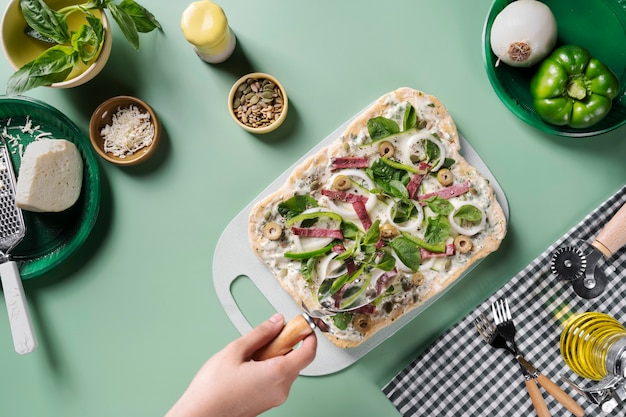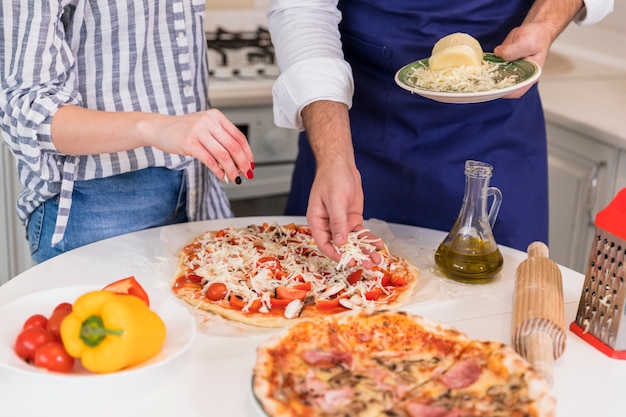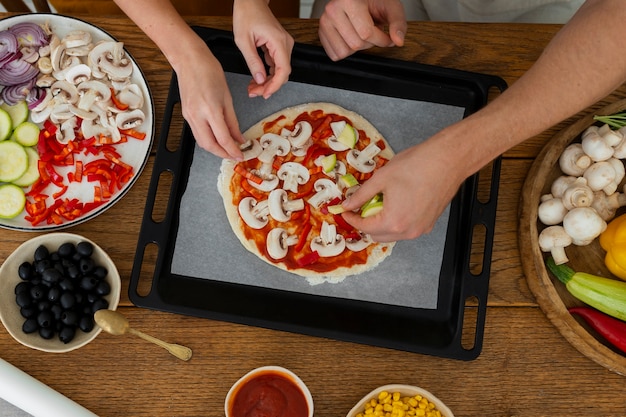We all have those nights where we crave the ultimate comfort food: pizza. But let's be honest, sometimes store-bought just doesn't cut it. You want something special, something that makes your taste buds sing with pure pizza joy. And that's where the pizza stone steps in, my friend.
I'm talking about a level of crispy, delicious pizza you've probably only dreamed of. Trust me, once you've had a pizza cooked on a pizza stone, your pizza game will be elevated to a whole new level. It's like a pizza party in your mouth, with a crust that's so crispy it practically sings and toppings that are cooked to perfection.
I've been a pizza stone enthusiast for years, experimenting with different types, doughs, toppings, and techniques. It's been a delicious journey, and I'm here to share all my secrets, tips, and tricks, so you can create pizza stone perfection in your own kitchen. Ready to embark on this journey with me? Let's get started!
(Part 1) The Pizza Stone: Your Secret Weapon

Imagine your favourite kitchen tools, the ones you can't live without. Well, the pizza stone has earned its place among them. It's truly a game-changer for any pizza lover. Why? Because it's all about heat distribution, my friend.
A pizza stone is like a heat sponge, soaking up the oven's heat and then evenly spreading it across your pizza. This creates a consistently hot environment that helps your pizza bake perfectly, resulting in that glorious crispy crust we all crave.
Why a Pizza Stone Works Wonders
- Crispy Crust Heaven: You know how you crave that perfect crunch? The pizza stone delivers. It gets so hot that it basically creates a base for your dough to cook evenly. This leads to a beautiful, airy crust with a satisfying bite, making you feel like you're biting into a delicious pizza cloud.
- Perfectly Even Baking: Remember that heat distribution we talked about? It's crucial for a perfectly cooked pizza. The pizza stone ensures that every single inch of your pizza gets the same amount of heat. No more burnt edges and undercooked centers, just pure pizza bliss.
- No More Soggy Bottoms: We've all had that pizza tragedy: the soggy bottom. It's like a pizza nightmare! With a pizza stone, your pizza is cooked directly on the surface, ensuring a crispy bottom and no unwanted sogginess. No more sad, drooping pizza slices!
- Versatility is Key: Don't think a pizza stone is just for pizza! I use mine for all sorts of culinary creations, from baking bread and flatbreads to roasting vegetables. It's a kitchen superhero, ready to tackle any challenge you throw its way.
(Part 2) Choosing Your Perfect Pizza Stone

Now, let's talk about pizza stones themselves. There are so many different types out there that it can feel a bit overwhelming, like trying to choose the perfect pizza topping! Don't worry, I'll guide you through the process, making it as simple as ordering a pizza.
1. Material Matters:
The pizza stone world has a few main contenders:
- Ceramic: This is a classic pizza stone material, known for its excellent heat distribution and durability. It's like the dependable friend you can always count on. The only downside is that it can be a bit heavier than some other options.
- Cordierite: A newer material, cordierite is like the lightweight champion. It's known for its heat-resistant nature and lightweight design, making it easy to handle and heat up quickly.
- Steel: If you're all about that ultimate crispy crust, steel is the material for you. It heats up fast and retains heat well, giving you that perfect crunch. However, it's important to remember that steel can be a bit more susceptible to warping if not cared for properly. So, treat it with care!
2. Size is King:
The size of your pizza stone depends on your oven and the size of the pizzas you want to make. If you're a regular pizza baker, a 14-inch stone is a good general size. But if you're baking for a crowd or want to make larger pizzas, a 16-inch stone will be your new best friend.
3. Thickness and Weight:
A thicker pizza stone is like a heat battery, retaining heat better, which can be fantastic for achieving that crispy crust. However, it's also heavier and might not fit in your oven if it's too thick. A thinner stone heats up faster but might not retain heat as well.
(Part 3) Prepping Your Pizza Stone: Get Ready to Bake!

You've got your pizza stone, and you're ready to make some pizza magic! Before you get started, there are a few simple steps to prepare your stone for baking. Think of it as a warm-up for your pizza stone superstar.
1. The First-Time Bake:
The first time you use your pizza stone, you need to "season" it. This helps to remove any impurities and get it ready for baking. Just heat the stone in your oven at a high temperature (around 500°F/260°C) for 30 minutes. This allows the stone to heat up evenly and release any residual moisture, making it ready for pizza perfection.
2. Flour Power:
Once your stone is preheated, lightly dust it with flour. This will prevent your pizza from sticking to the surface and ensure a clean release, allowing your pizza to slide off without any mishaps.
3. Don't Forget the Rack:
Place your pizza stone on the middle rack of your oven. This ensures even heat distribution and allows for a crispy crust, making sure that every inch of your pizza gets that perfect bake.
(Part 4) Making Pizza Dough for Pizza Stone Perfection
Okay, now we're getting into the good stuff - pizza dough! You can always buy pre-made dough, but I prefer making my own. It's surprisingly easy, and you get to control the ingredients and flavour. Plus, there's a certain satisfaction that comes with creating your own pizza dough masterpiece.
1. The Basic Recipe:
Here's a simple pizza dough recipe that I've been using for years, a tried-and-true method that always delivers:
- Ingredients:
- 1 cup warm water
- 1 teaspoon active dry yeast
- 1 teaspoon sugar
- 2 tablespoons olive oil
- 1 teaspoon salt
- 3 cups all-purpose flour, plus more for dusting
- Instructions:
- Combine the warm water, yeast, and sugar in a large bowl. Let it stand for 5 minutes, until the yeast is foamy. This is how you know your yeast is happy and ready to work its magic!
- Add the olive oil, salt, and 2 cups of flour to the yeast mixture. Stir until well combined, making sure all the ingredients are happily mingling together.
- Gradually add the remaining flour, 1 cup at a time, until the dough is smooth and elastic. This means it should be soft and flexible, not too sticky.
- Turn the dough out onto a lightly floured surface and knead for 5-7 minutes, until smooth and elastic. This is where you get to flex your dough-making muscles!
- Place the dough in a lightly oiled bowl, cover with plastic wrap, and let it rise in a warm place for 1-2 hours, or until doubled in size. This is the time for the dough to relax and grow, getting ready for the big pizza moment.
- Punch down the dough and divide it into 2-3 balls. This is your chance to let out any pent-up dough energy!
- Cover the dough balls and let them rise for another 30 minutes. It's like a second wind for your dough, allowing it to reach its full potential.
- Preheat your oven to 500°F/260°C. Place your pizza stone in the oven to preheat. This is the crucial step, allowing your stone to reach its optimal temperature for the perfect pizza bake.
2. Play with Flavours:
The best part about making your own dough is that you can experiment with flavours. Don't be afraid to get creative! Try adding a tablespoon of dried oregano or basil, or a teaspoon of garlic powder for a taste explosion.
3. Let's Get Kneady:
Kneading the dough is essential. It helps develop the gluten, which gives your pizza crust that chewy texture. Don't be afraid to get your hands dirty and give the dough a good workout. It's all part of the pizza-making journey!
(Part 5) Crafting the Perfect Pizza
Now, let's get to the fun part - crafting your pizza! I'm going to share some tips and tricks to help you create a masterpiece on your pizza stone, making you feel like a true pizza artist.
1. The Art of Stretching:
- The "Donut Method": This is my go-to method for stretching dough, a simple but effective technique. Form a ball of dough, then use your fingers to create a hole in the centre. Gently stretch the dough outwards from the hole, forming a circular shape.
- Don't Overwork It: Don't be tempted to over-stretch the dough. You want a slightly thicker crust, not a thin, fragile one.
- Flour is Your Friend: Generously dust your work surface and your hands with flour to prevent the dough from sticking. This will ensure a smooth and effortless stretch.
2. The Sauce Story:
- Keep it Simple: A basic tomato sauce is often all you need. You can find pre-made sauce at the supermarket, or make your own.
- Flavour Fusion: Get creative with your sauce! Add herbs like oregano, basil, or rosemary for a burst of flavour, turning your sauce into a flavourful masterpiece.
- Don't Drown It: You don't want to use too much sauce. Just a thin layer is enough to cover the base and provide a flavour foundation.
3. Topping Time:
- Keep it Balanced: Think about the flavours and textures you want to create. Balance out heavier toppings like pepperoni with lighter ones like vegetables, creating a symphony of tastes in every bite.
- Less is More: Don't overload your pizza with toppings. It can make the dough soggy and make it difficult to cook properly. You want your toppings to complement, not overpower, the pizza.
- Cheese Please: Mozzarella is the classic pizza cheese, but feel free to experiment with other cheeses like cheddar, provolone, or even goat cheese. You can create your own cheese symphony, making each pizza a unique experience.
(Part 6) Baking Your Pizza Masterpiece
Now, the moment of truth - baking your pizza! This is where your pizza stone really shines, taking your pizza from good to glorious.
1. The Perfect Oven Temperature:
Most pizza stones recommend baking at high temperatures (500°F/260°C). This intense heat is what helps create that perfectly crispy crust, making you feel like you're in a pizza paradise.
2. Slide and Bake:
- Flour Power: Lightly dust a pizza peel or a large baking sheet with flour. This will help the pizza slide easily onto the hot pizza stone, ensuring a smooth transition into the oven.
- Slide it On: Carefully slide the pizza onto the preheated pizza stone. You may need to give it a gentle nudge to ensure it's sitting evenly on the stone.
- Close and Wait: Close the oven door and allow the pizza to bake for 8-12 minutes, or until the crust is golden brown and the cheese is bubbly. This is the time to let the pizza stone work its magic.
3. The "Bake Test":
- The "Lift and Peek": After about 5 minutes, use a pizza peel to carefully lift the edge of the pizza to check the crust. It should be golden brown and slightly crispy.
- The "Cheese Check": The cheese should be bubbly and starting to brown around the edges, a sign that your pizza is reaching peak deliciousness.
- Adjust as Needed: If the crust is browning too quickly, you might need to lower the oven temperature slightly. If the cheese isn't melting properly, you might need to bake it for a little longer.
(Part 7) Pizza Stone Care and Maintenance
You've got your beautiful, crispy pizza, and you're ready to dig in. But wait! Don't forget about your trusty pizza stone. It needs a little TLC too, to keep it in top shape for all your future pizza adventures.
1. Cool Down:
Never plunge a hot pizza stone into cold water. It can cause it to crack. Let the stone cool down naturally on the countertop or in the oven with the door open.
2. Cleaning Time:
- Let It Cool: Wait until the stone is completely cool before cleaning it. This ensures that you don't accidentally crack it.
- The Right Tools: Use a scraper or brush to remove any stuck-on food. Avoid using sharp objects that could scratch the surface.
- The Soap-Free Scrub: Wash the stone with warm water and a mild dish soap. Rinse thoroughly and let it air dry completely.
- No Dishwasher: Pizza stones are not dishwasher-safe. The high heat and detergents can damage the stone.
3. Storage Solutions:
- Let It Breathe: Store your pizza stone in a dry, well-ventilated area. This will help prevent it from absorbing moisture and developing mildew.
- Protect It: You can use a pizza stone cover to protect it from dust and scratches, ensuring it stays in perfect condition for years to come.
(Part 8) Beyond Pizza: Exploring Your Pizza Stone's Potential
Did you know that a pizza stone is not just for pizza? It's a culinary chameleon, ready to take on a variety of baking and cooking challenges.
1. Bread Baking Bliss:
- Crispy Crusts: A pizza stone is perfect for baking loaves of bread with a delicious, crispy crust. Simply preheat your stone, place your dough on it, and bake as usual.
- No More Sticking: The smooth surface of the stone prevents bread dough from sticking, ensuring a clean release.
- Even Browning: The even heat distribution of the stone ensures that your bread bakes evenly, resulting in a perfectly browned crust.
2. Flatbread Fun:
- Quick and Easy: Flatbreads are a great way to use your pizza stone. They bake quickly and are perfect for topping with all sorts of delicious ingredients.
- The Perfect Base: The stone gives flatbreads a crispy, slightly charred texture, adding a delightful touch of smokiness.
- Endless Possibilities: Get creative with your toppings! Try hummus, vegetables, cheese, or even a simple sprinkle of salt and pepper.
3. Roasted Vegetables:
- Crispy and Delicious: Roasting vegetables on a pizza stone creates a beautiful caramelization and a crispy exterior, making them both delicious and visually appealing.
- Even Cooking: The stone ensures that vegetables cook evenly, no matter their size or shape, bringing out the best in every vegetable.
- Flavor Boost: The high heat of the stone helps to intensify the natural flavors of the vegetables, making them even more delicious.
(Part 9) FAQ: Your Pizza Stone Queries Answered
I'm sure you have a few questions about pizza stones, and I'm here to answer them. Here are some common questions that I get asked frequently.
1. Can I Use a Pizza Stone on a Gas Grill?
Yes, you can! In fact, using a pizza stone on a gas grill is a great way to achieve that smoky flavour. Just preheat your grill to high heat and place the pizza stone directly on the grill grates.
2. What's the Best Way to Clean a Pizza Stone?
As I mentioned before, cleaning a pizza stone is simple. Let it cool completely, then use a scraper or brush to remove any stuck-on food. Wash the stone with warm water and a mild dish soap, rinse thoroughly, and let it air dry completely. Never put it in the dishwasher!
3. How Long Should I Preheat My Pizza Stone?
Preheat your pizza stone in a 500°F/260°C oven for at least 30 minutes. The hotter the stone, the crispier your crust will be.
4. Can I Use My Pizza Stone to Bake Cookies?
While you can use a pizza stone to bake cookies, it's not the most ideal solution. The high heat of the stone can cause cookies to burn easily.
5. How Long Does a Pizza Stone Last?
With proper care, a pizza stone can last for years. Just avoid exposing it to extreme temperature changes and keep it clean.
Pizza Stone Perfection: The Final Word
There you have it, my guide to pizza stone perfection! I hope you've learned a thing or two about how to create delicious, crispy pizzas and explore the versatility of your pizza stone. Remember, practice makes perfect. The more you use your pizza stone, the more confident you'll become. And soon, you'll be whipping up pizza masterpieces in no time!
So, what are you waiting for? Get yourself a pizza stone, gather your ingredients, and let's get baking!
Everyone is watching

Prime Rib Roast Cooking Time Chart: Per Pound Guide
Cooking TipsPrime rib roast. Just the name conjures images of lavish dinners, crackling fires, and hearty laughter. It’s ...

How Long to Bake Potatoes in the Oven (Perfect Every Time)
Cooking TipsBaked potatoes are a staple in my kitchen. They're incredibly versatile, delicious, and surprisingly easy to m...

Perfect Rice Every Time: The Ultimate Guide to Cooking Rice
Cooking TipsAs a self-proclaimed foodie, I've always been a bit obsessed with rice. It's the foundation of countless cuisi...

The Ultimate Guide to Cooking Asparagus: Tips, Techniques, and Recipes
Cooking TipsAsparagus. The mere mention of this spring delicacy conjures up images of vibrant green spears, crisp and burs...

Ultimate Guide to Cooking the Perfect Thanksgiving Turkey
Cooking TipsThanksgiving. Just the word conjures up images of overflowing tables laden with delicious food, the scent of r...
